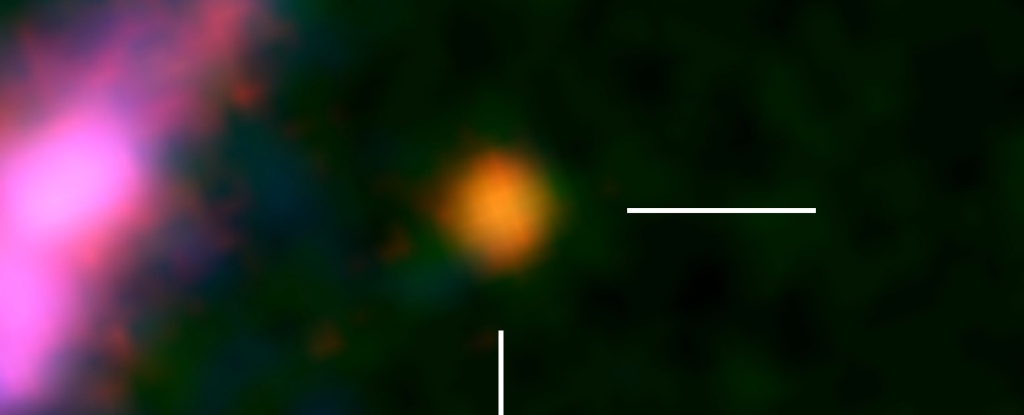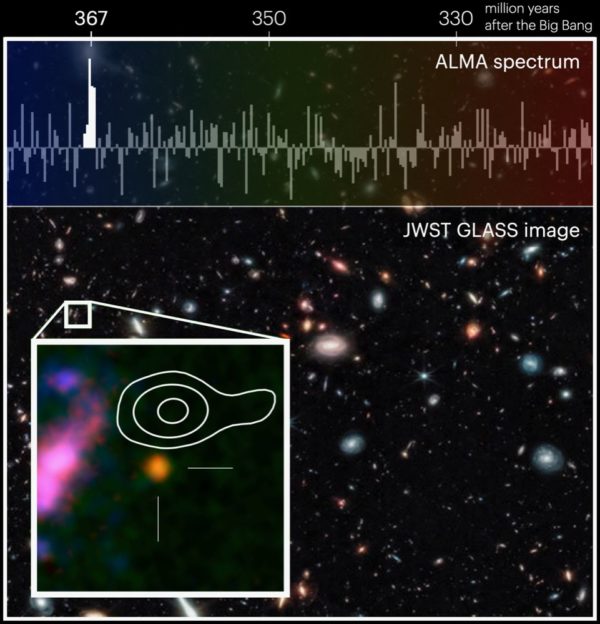
Posted on 01/30/2023 10:51:14 AM PST by Red Badger

Distant Galaxy
The image of the most distant galaxy, GHZ2/GLASS-z12. (NASA/ESA/CSA/T. Treu, UCLA/NAOJ/T. Bakx, Nagoya U)
A galaxy whose light has traveled nearly 13.5 billion years to reach us has just been confirmed as the earliest galaxy found to date.
By studying the oxygen content of the galaxy with the Atacama Large Millimeter/submillimeter Array (ALMA), astronomers have precisely dated it to just 367 million years after the Big Bang, a time when the first lights in the Universe were still switching on and starting to propagate freely through space.
The result confirms observations made by JWST, and offers new information about the early Universe that tells us about the origins of the elements.
"The first images of the James Webb Space Telescope revealed so many early galaxies that we felt we had to test its results using the best observatory on Earth," says astronomer Tom Bakx of Nagoya University in Japan.
"It was a very exciting time to be an observational astronomer, and we could track the status of the observations that will test the JWST results in real time."
The galaxy, named GHZ2/GLASS-z12, was first spotted by JWST in July of last year, not long after the telescope opened its segmented golden eye on the infrared light of the Universe.
A paper in November detailed the discovery, dating the galaxy back to approximately 350 million years after the Big Bang, which took place around 13.8 billion years ago.
That's actually pretty amazing, but any astronomical discovery is significantly more robust if it can be confirmed using an independent instrument.
So a team led by Bakx and astronomer Jorge Zavala of the National Astronomical Observatory of Japan turned to radio telescope ALMA to see what more they could learn about the fledgling galaxy.
They turned ALMA to the direction of GHZ2/GLASS-z12 and started looking for an emission signature on the radio spectrum associated with oxygen.
Since oxygen takes a relatively short time to form, it's commonly used to learn more about galaxies in the early Universe. And when light enters oxygen, it is re-emitted at a specific wavelength range, resulting in a brighter line on that part of the spectrum.

The image of GHZ2/GLASS-z12 with the associated ALMA spectrum. (NASA/ESA/CSA/T. Treu, UCLA/NAOJ/T. Bakx, Nagoya U)
Each of the 66 12-meter radio antennae that make up ALMA were put to work, ultimately detecting an oxygen emission line close to the position of GHZ2/GLASS-z12. Follow-up analyses and statistical tests determined that the signal was real, and related to the galaxy.
"We were initially concerned about the slight variation in position between the detected oxygen emission line and the galaxy seen by Webb," Bakx explains.
"But we performed detailed tests on the observations to confirm that this really is a robust detection, and it is very difficult to explain through any other interpretation."
The very slight distance between the galaxy and the oxygen emission could suggest that violent explosions or interactions stripped the galaxy of a great deal of its gas, blowing it out into intergalactic space.
The team dated their observations to a more precise 367 million years after the Big Bang. And, based on the brightness of the emission line, they were able to infer that the galaxy had relatively quickly formed high abundances of elements heavier than hydrogen and helium.
This is very interesting. The early Universe, before stars came along, was mostly made up of hydrogen with a smaller amount of helium. Then stars formed; in their hot, dense cores, they started smashing atoms together, creating heavier elements.
But these elements were locked inside the stars; it wasn't until the stars had died, exploding in spectacular supernovae, that heavier elements were able to spread through interstellar space.
This presence of oxygen so early in the Universe gives us some clues about the timing and evolution of these first stars, which we have yet to see directly.
"These deep ALMA observations provide robust evidence of the existence of galaxies within the first few hundred million years after the Big Bang, and confirms the surprising results from the Webb observations," Zavala says.
"The work of JWST has only just begun, but we are already adjusting our models of how galaxies form in the early Universe to match these observations. The combined power of Webb and the radio telescope array ALMA give us the confidence to push our cosmic horizons ever closer to the dawn of the Universe."
The research has been published in the Monthly Notices of the Royal Astronomical Society.
Save this TITLE.... We can use it again!................
How do they really know? Nothing but total darkness with a big spot in the middle? Yeh, well, there’s a couple light spots in the same pic. May as well call them galaxies, cuz what else can source that much light from such great distances?
A hilarious adverb used here.
So in other words we are looking at a galaxy 13.5 billion years ago. That time is so beyond human comprehension. It’s like trying to imagine the vacancy of Joe Bidens brain, nothingness upon nothingness, zero upon zero,
A million here, a million there, and pretty soon you’re talking about real time!..................
I’m just a dumb layman, but if the first lights were just coming on at that time, how are there already fully formed galaxies full of mature stars with heavy elements?
At some point they will find THE MOST DISTANT GALAXY EVER...........................
The stars were of hydrogen and the galaxies were globular............
Big whoop. I see a lot of cash wasted for little to no benefit.
Let’s spend for research and exploration in the near-earth area of our solar system.
“I’m just a dumb layman, but if the first lights were just coming on at that time, how are there already fully formed galaxies full of mature stars with heavy elements?”
To answer:
1) stars form when enough dust gathers in one place. Usually that process leads to many stars forming at once. So we get galaxies pretty early.
2) One of the things that is interesting about these galaxies is they are missing the heavy elements. Almost all primordial hydrogen and helium without the wider collection we see in our stars.
Observations could outstrip their ability to adjust their models to fit those observations.
Potentially leading to an imperative to throw said models in the ash pit of scientific history.
Concur.
I had to check to see if this was the Babylon Bee.
LOL!
There was no big bang, ever.
“Big whoop. I see a lot of cash wasted for little to no benefit.”
Perhaps, but perhaps it is asking these most important questions that will get the most important answers.
It started as whispers, but there is an ever growing conversation among physicists that our universe shows clear evidence for being created.
I think there is a real chance that in the next few decades science proves the existence of God.
Imagine the consequences of that. The secularization of our society that has been going on for 100 years could be suddenly reversed.
Of course not.
Sound does not travel in a vacuum...................
If we don’t know ‘when’, how can we tell how long ‘after’?................
Disclaimer: Opinions posted on Free Republic are those of the individual posters and do not necessarily represent the opinion of Free Republic or its management. All materials posted herein are protected by copyright law and the exemption for fair use of copyrighted works.